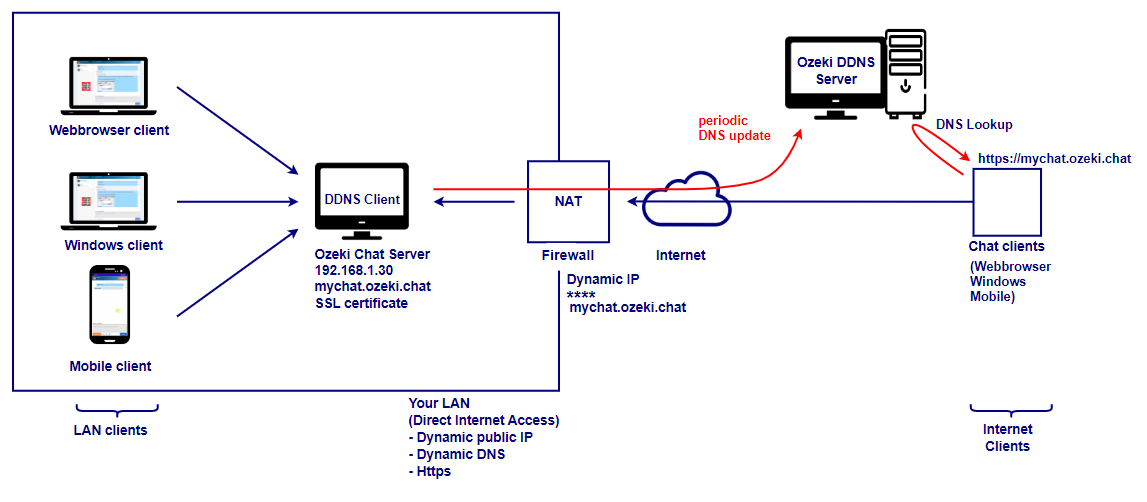On-Premises Chat Server with Dynamic IP
Deploying Ozeki Chat Server on-premises offers organizations a powerful platform for internal communication. However, when the firewall within the LAN has a dynamic IP address assigned by the Internet Service Provider (ISP), additional considerations and configurations are necessary to ensure seamless connectivity for remote chat clients. This lecture explores the steps to effectively set up Ozeki Chat Server in such environments, maximizing accessibility and security for both local and remote users.
Dynamic IP Address Firewall Configuration
In scenarios where the LAN firewall's IP address is dynamically assigned by the Internet Service Provider (ISP), maintaining consistent connectivity for remote clients becomes challenging. Unlike the access point for on-premises chat systems with fixed IP addresses, dynamic IP addresses can change periodically, requiring dynamic DNS (DDNS) services to keep track of the changing IP address and ensure remote access remains uninterrupted.

Dynamic DNS (DDNS)
Implementing a Dynamic DNS (DDNS) service (Figure 1) allows organizations to associate a domain name with the dynamic IP address assigned to the firewall. DDNS continuously updates the domain name's DNS records with the firewall's current IP address, ensuring remote clients can reliably locate and connect to the Ozeki Chat Server regardless of changes in the firewall's IP address.
Configuration Steps
Select a DDNS Service Provider: Choose a reputable DDNS service provider that offers reliable and secure dynamic DNS management capabilities.
Register a Domain Name: Register a domain name with the chosen DDNS service provider. This domain name will serve as the public-facing address for accessing the Ozeki Chat Server.
Configure DDNS Settings on the Firewall: Access the firewall's configuration interface and navigate to the DDNS settings. Enter the credentials provided by the DDNS service provider, including the domain name, username, and password. Configure the firewall to periodically update the DDNS service with its current IP address.
Port Forwarding: Configure port forwarding on the firewall to direct incoming traffic on the designated port (e.g., port 80 for HTTP or port 443 for HTTPS) to the internal IP address of the Ozeki Chat Server. This allows remote clients to establish connections with the server through the firewall.
SSL Certificate Installation: Install an SSL certificate on the Ozeki Chat Server to encrypt communication between remote clients and the server, ensuring data security and privacy.
Conclusion
By effectively configuring Ozeki Chat Server in environments where the LAN firewall has a dynamic IP address, organizations can overcome connectivity challenges and provide seamless communication for both local and remote users. Leveraging Dynamic DNS services, port forwarding, and SSL encryption enhances accessibility and security, empowering organizations to maximize the benefits of on-premises chat server deployment. With these configurations in place, organizations can facilitate efficient collaboration and communication across their network while maintaining data integrity and confidentiality.

